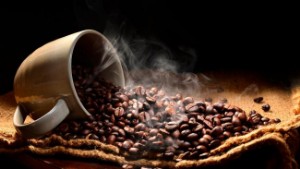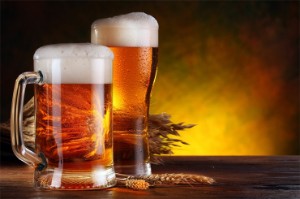Does tea widen the lumen of blood vessels or narrows them — an overview of the influence of 7 varieties of the drink
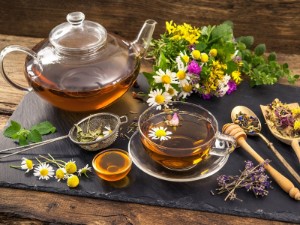 There is a lot of confusion around the problem of tea's effect on the cardiovascular system.
There is a lot of confusion around the problem of tea's effect on the cardiovascular system.
This is due to the fact that, firstly, medicine itself has not fully answered questions about the effect of tea on the CCC , and secondly, its popularizers do not always correctly present information about the effects on the body.
For example, it is impossible to say unequivocally whether strong black tea is useful for hypotension, because it depends not only on a person's blood pressure, but also on many other factors. It is also impossible to say that green tea is always indicated for hypertension.
So, One study indicates indicates that strong tea (both black and green) increases blood pressure for a short time.
Other studies ( 1 , 2 ) indicate that regular and moderate consumption of both types of tea reduces blood pressure in the long run.
In this article, we will try to figure out all these subtleties.
Content
Effects on the vessels of 7 different types of drink
A classic tea is considered to be a drink made from raw materials obtained from a tea bush. Although tea is called both floral and herbal collections, and such specific plants as mate or rooibos.
Depending on their specifics and processing, different teas have different properties and have different effects on blood vessels, heart and brain. Which drink dilates blood vessels the most &8212; find out below.
1. Green
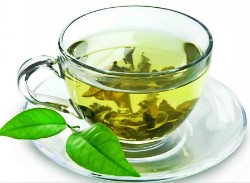 Any tea contains alkaloids, minerals and vitamins, which at different times of brewing and consumption have different effects on blood pressure, blood vessels and the brain.
Any tea contains alkaloids, minerals and vitamins, which at different times of brewing and consumption have different effects on blood pressure, blood vessels and the brain.
In this case, the vessels of the brain and abdominal cavity may narrow, and the vessels located in the muscles, including the coronary ones, may expand. And vice versa. Hence, there was confusion about the effect of tea on blood vessels.
The most famous alkaloid is caffeine. It causes an increase in blood pressure, tones well, and improves brain activity. Green tea has a lot more caffeine than black tea. Therefore, there was a theory that green tea is useful for hypotension. Is it so?
Indeed, green tea narrows the lumen of the arteries, raises blood pressure and invigorates in general, relieves headaches, as it narrows and tones the walls of the cerebral vessels.
But this effect doesn't last long, because other alkaloids begin to act: theobromine, xanthine, nofilin, paraxanthin, hypoxanthine. They reduce the tone of the blood vessels of the brain, lowering blood pressure. At the same time, the hypotonic's head begins to hurt again.
An incorrectly oriented patient who does not control his blood pressure, especially if the body is prone to pressure surges, may mistake a headache from spasms of cerebral vessels with hypertension for pain from hypotension and brew himself strong green tea. As a result, a hypertensive person provokes a hypertensive crisis before receiving a decrease in pressure.
Thus, green tea is more suitable not for hypotension, but for hypertensive patients . But on one condition: it should not be too strong.
In addition to toning the body and reducing high blood pressure, this drink has several more beneficial properties.
- Anti-sclerotic effect . It not only lowers cholesterol levels in the blood, but can also dissolve cholesterol plaques on the walls of arteries, as well as make blood vessels more elastic. More about that, which teas will cleanse the vessels , see in a separate article.
- Protective properties. Protects against cancer, boosts the immune system and is a natural antioxidant.
- A remedy for excess weight. With regular use, it improves metabolism and can be regarded as a weight loss remedy. But it has a cumulative effect. In order to lose weight and thereby facilitate the work of blood vessels and the heart for a long time, it is consumed weakly at least three times a day after meals. But its use for weight loss is possible only without sweets and the addition of milk.
It is better to abstain from the drink in acute gastritis, gastrointestinal ulcers, heartburn, abdominal cramps and stomach pain of any etiology.
The technology of its preparation consists of light drying for a short time, temperature treatment, during which all fermentation processes are completely stopped, and twisting of the leaves. The leaves are given the most bizarre shape, and the steeper the leaves are folded, the stronger the drink will be.
It is brewed with 60-80-degree water from 2 to 6 times.
2. Black
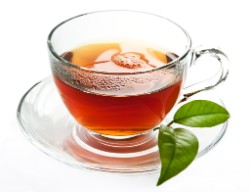 Black tea in the first phase also increases blood pressure
and tones up all systems. And in the second stage, it works differently than the green one.
Black tea in the first phase also increases blood pressure
and tones up all systems. And in the second stage, it works differently than the green one.
Since black is fermented much more strongly, vitamins B, P and PP are preserved in its leaves. They help blood pressure stability after caffeine stops acting. Therefore, the drink is very suitable for hypotension, although it does not raise blood pressure as fast as green.
Black tea has another one Useful for cores property: Quercetin contained in it prevents blood clots from forming in vessels. This is a big plus. But it can also damage if a lot of the drink is consumed in parallel with blood thinning drugs.
He is also:
- Reduces the amount of &171;bad&187; cholesterol;
- Reduces the likelihood of stroke by 60-70%;
- Improves brain performance, increases concentration;
- Weakly stabilizes blood pressure, relieves pressure surges.
It is not necessary to drink strong black tea for those who have a stomach ulcer. It can exacerbate inflammation of the mucous membrane and cause bleeding.
The fermentation process is long and multi-stage, it depends on the variety of the tea bush. It is brewed with water up to 90 degrees, has the largest amount of substances that carry benefits for blood vessels , but requires the most attention to brewing technology.
3. White
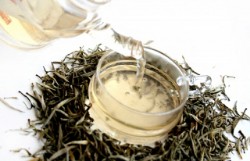 The name comes from the type of raw material, which consists of buds and young leaves covered with thin white hairs. Some fans of the drink believe that it is the most useful, since it is almost not fermented, only slightly dried in the sun and then dried in the shade.
The name comes from the type of raw material, which consists of buds and young leaves covered with thin white hairs. Some fans of the drink believe that it is the most useful, since it is almost not fermented, only slightly dried in the sun and then dried in the shade.
For the cardiovascular system it is interesting because:
- Strengthens the walls of blood vessels, therefore it is especially useful for women with varicose veins;
- Prevents cancer, including the organs of the cardiovascular and circulatory systems;
- Strengthens the immune system and preserves youth, as it outperforms orange juice by 4 times in terms of antioxidant content.
4. Yellow
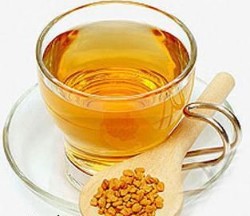 The drink turns out to be strong, quickly toning up, with a very subtle, delicate aroma. Like black tea, yellow raises blood pressure, is therefore indicated for hypertensive patients.
The drink turns out to be strong, quickly toning up, with a very subtle, delicate aroma. Like black tea, yellow raises blood pressure, is therefore indicated for hypertensive patients.
It can be recognized by its reflection in a white porcelain cup: green tea will have a yellowish or greenish tinge, and yellow tea will have a pinkish tinge.
Refers to the weakly fermented. It takes 72 hours to prepare: first, the dense, juicy, yellowish, small buds of the tea bush are dried over coals, then they are wrapped in parchment for slow fermentation, &8212; during this time, the white villi are destroyed. Brew with water 60-70 degrees.
5. Oolong
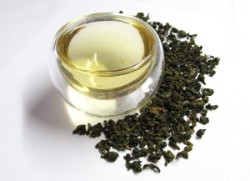 Oolong has the properties of both green and black teas in relation to vessels, but the taste characteristics of this drink are richer than those of others. The effect on the lumen of the arteries is mostly neutral.
Oolong has the properties of both green and black teas in relation to vessels, but the taste characteristics of this drink are richer than those of others. The effect on the lumen of the arteries is mostly neutral.
This is a semi-fermented drink, average between green and black. The preparation of raw materials takes place in several stages: first, it is dried for about an hour, then placed on bamboo baking sheets and from time to time stirred so that the leaves slightly oxidize and change color in places, then calcined several times alternately over an open fire, cooled, rolled up and boiled again.
6. Pu Er
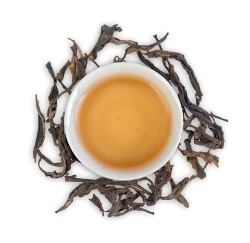 This drink narrows the lumen of the arteries even more and increases blood pressure than black.
Is contraindicated in hypertension.
This drink narrows the lumen of the arteries even more and increases blood pressure than black.
Is contraindicated in hypertension.
Highly fermented, it has pronounced taste characteristics and a strong effect on the body. It is brewed only with boiling water, in special ways.
This is due to the fact that fermentation takes place not only for a long time, but also after pressing. Currently, additional fermentation methods are also used, since in modern consumer conditions Pu Air does not have time to mature after pressing.
Also check out the infographic:
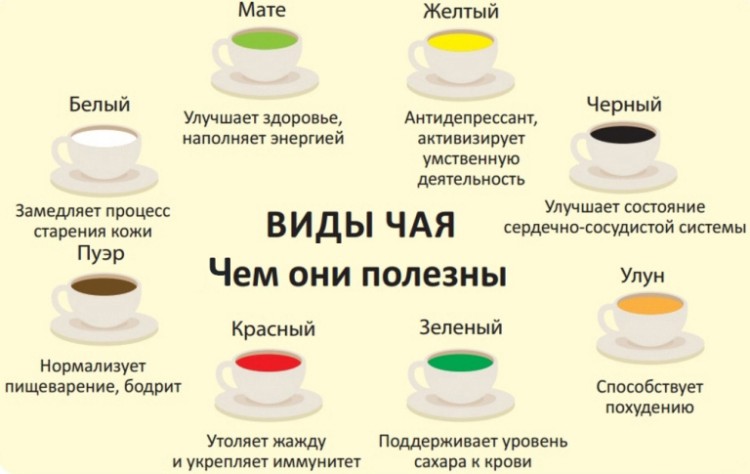
What does the fortress affect?
Black tea gains its strength in an average of 5 minutes after the start of brewing, green tea in 7 minutes. At this point, the teas have the best aroma and taste qualities. Later, the drink becomes not stronger, but richer in color, but loses the properties that characterize the fortress as fully as possible: essential oils evaporate, vitamins decompose, etc.
At the moment of its highest strength, tea has the greatest effect on the vessels of the brain and the heart.
Sometimes a strong drink helps to improve the condition. For example, strongly brewed black tea with headache and low blood pressure, it will relieve spasm, raise blood pressure and prevent it from falling again.
But even a hypotonic person has a large amount of strong green tea can immediately cause unpleasant symptoms:
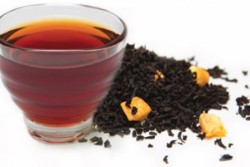
- Thyroid problems;
- Strong heartbeat;
- Trembling of hands and feet;
- Sleep disorders.
Therefore, it is advisable to brew only black tea strongly and only if we are talking about hypotension, which does not have sudden pressure surges. But a medium-strength drink will help him no worse, without giving side effects.
How hot should it be?
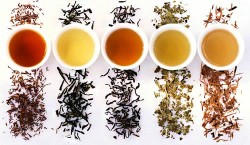 The optimal temperature for drinking is considered to be about 56 degrees. Being hotter, it provokes malignant formations of the throat and stomach, overcooled &8212; reduces its healing properties.
The optimal temperature for drinking is considered to be about 56 degrees. Being hotter, it provokes malignant formations of the throat and stomach, overcooled &8212; reduces its healing properties.
However, in culture, for example, American civilization, it is practically not accepted to drink this drink hot.
Oriental traditions suggest that the more fermented tea is, the hotter it should be consumed: otherwise it is tasteless and does not give any beneficial effect.
White and green teas, respectively you can drink even cold , if such use is comfortable. Provided they are chilled but fresh.
Interesting facts
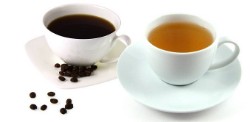 Experts claim that green tea has even more caffeine than natural brewed coffee. The specific composition depends on the size of the leaves (the smaller they are, the more caffeine) and on the brewing temperature: the hotter the water, the more caffeine in the cup.
Experts claim that green tea has even more caffeine than natural brewed coffee. The specific composition depends on the size of the leaves (the smaller they are, the more caffeine) and on the brewing temperature: the hotter the water, the more caffeine in the cup.
Therefore, if the task is to tone the body and raise blood pressure, then green tea is even preferable.
But if you need to bring a person into a cheerful state, but he is prone to jumps. , then it is better to choose not coffee or green tea, but black. In it, caffeine acts more mildly, thanks to tannins. But even in this case, it is necessary to observe a measure regarding the strength and amount of alcohol consumed.
Learn more about the benefits of coffee for the heart and blood vessels see in a separate article
It is believed that depending on the state of health and age, it is safe to consume 4-8 cups of a competently brewed drink.
Useful video
And now we invite you to familiarize yourself with the video:
Total, tea is not a medicinal product. But it can have a very beneficial effect on blood vessels and heart muscle if you choose the right kind of drink, brew it correctly and consume it.
